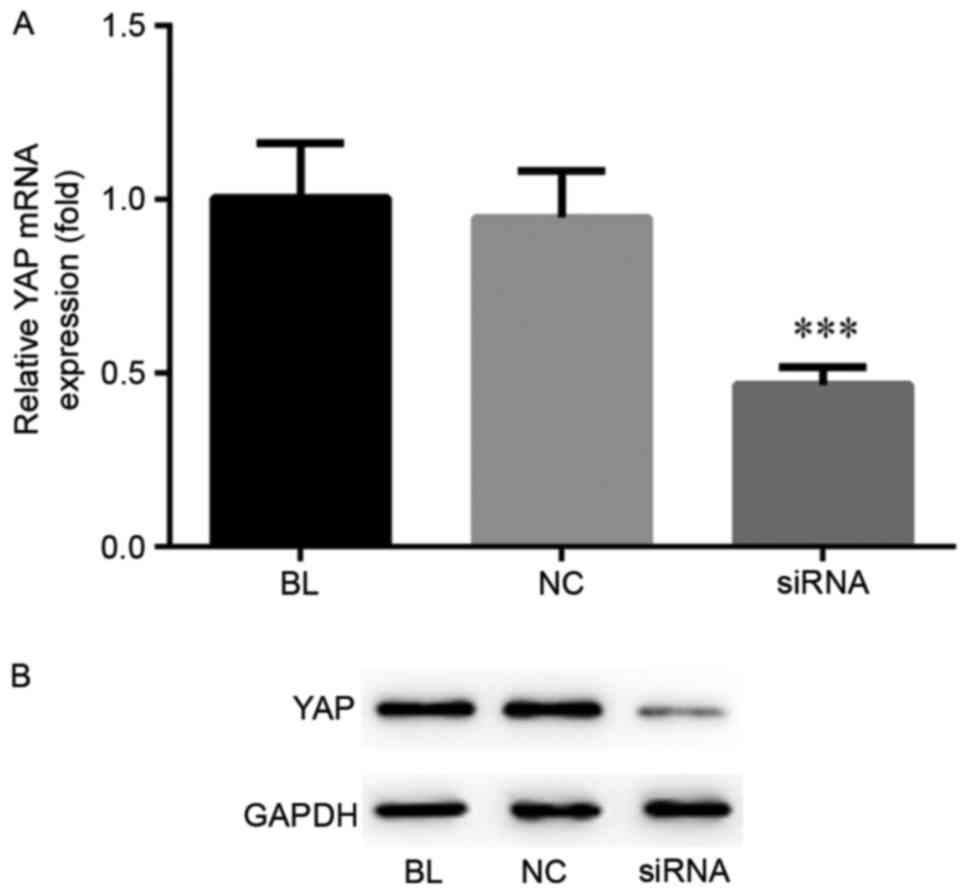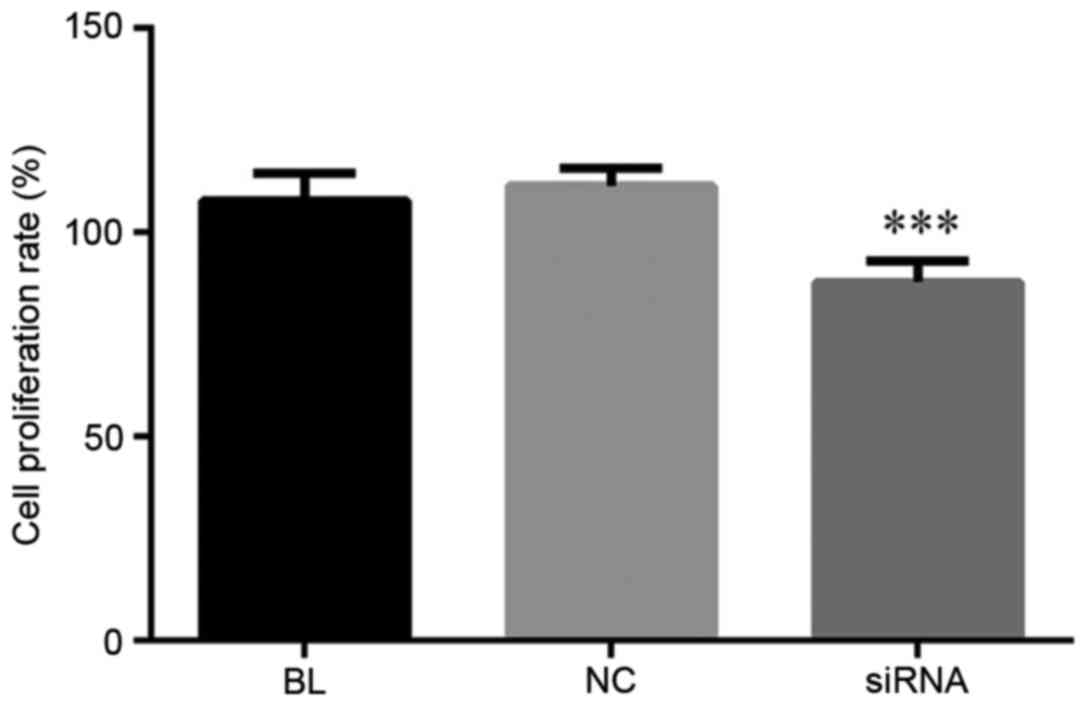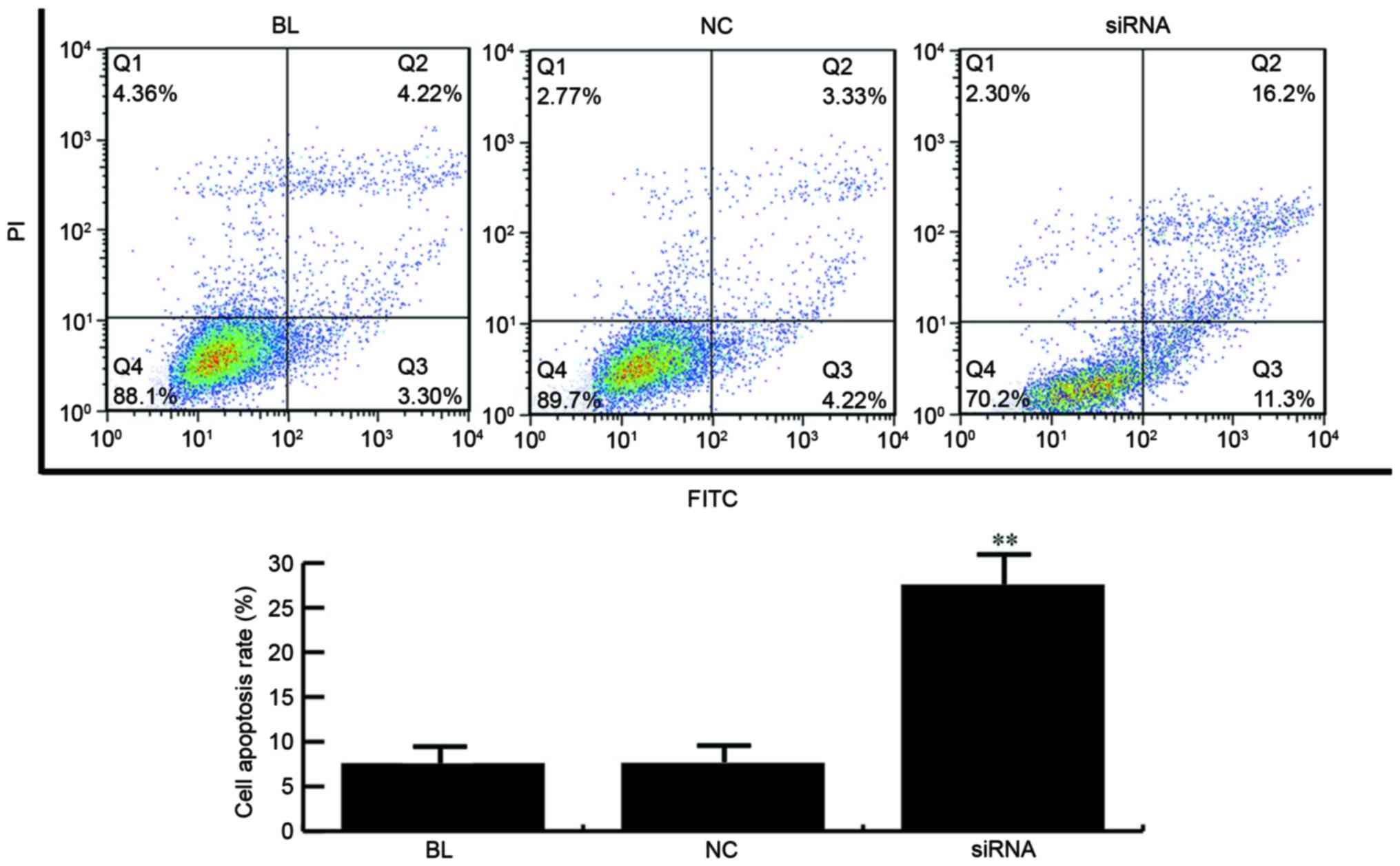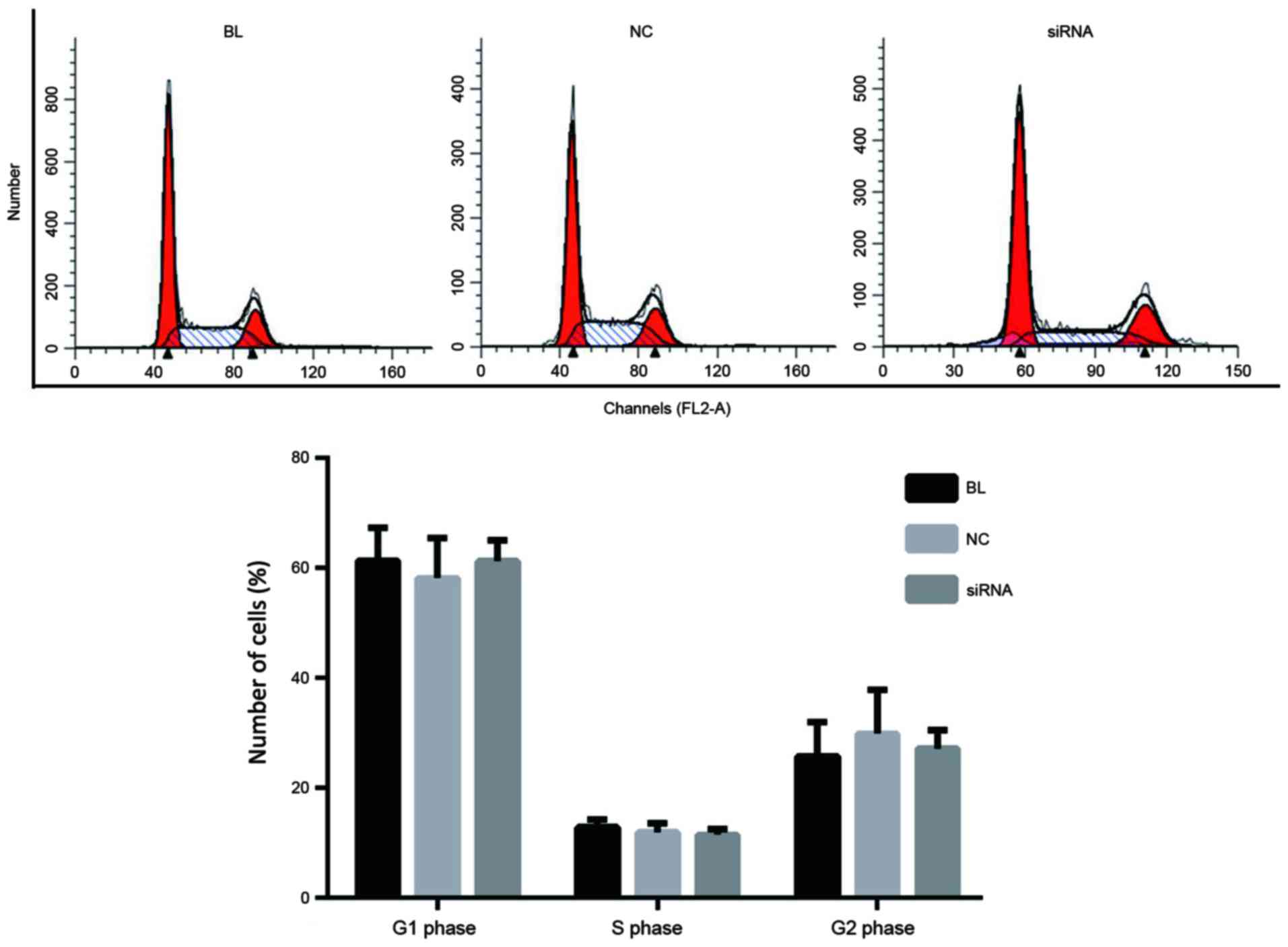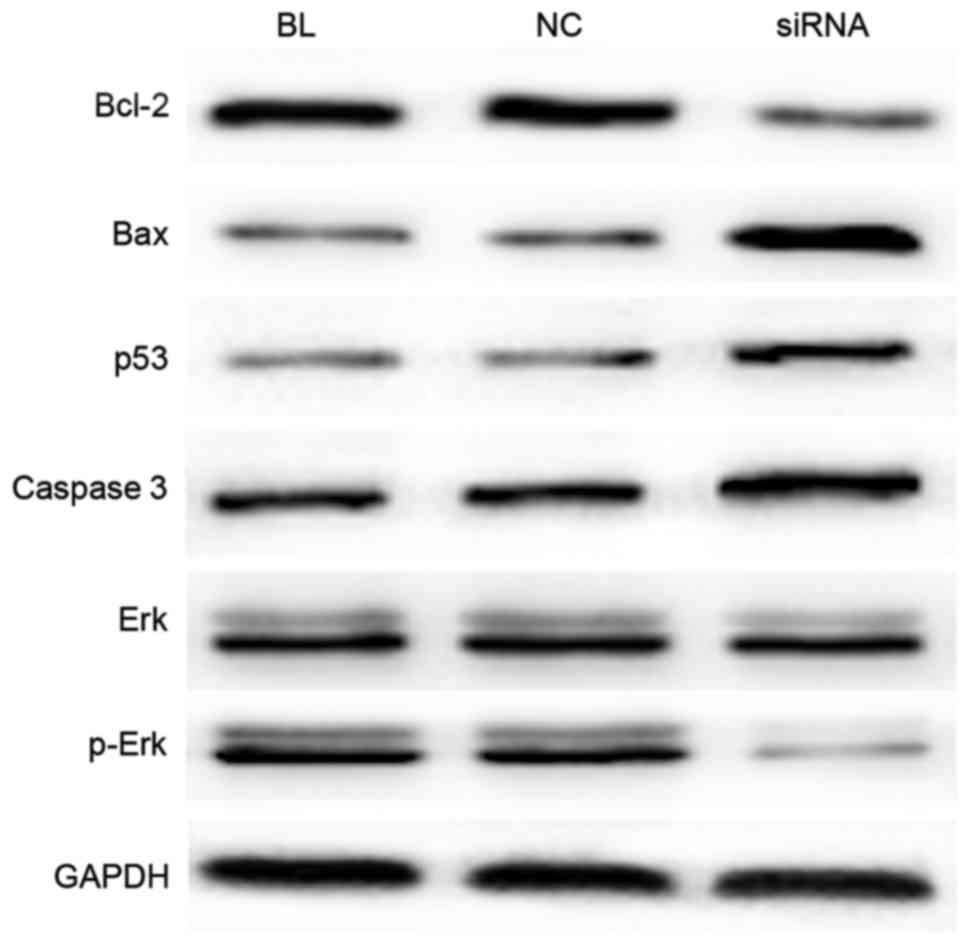Downregulation of YAP inhibits proliferation and induces apoptosis in Eca‑109 cells
- Authors:
- Published online on: November 10, 2017 https://doi.org/10.3892/etm.2017.5492
- Pages: 1048-1052
Abstract
Introduction
Esophageal cancer is one of the eight most common human tumors worldwide, which commonly occurs in the esophageal mucosal epithelium or gland, and its mortality rate ranked sixth worldwide (1,2). Approximately 482,300 patients were newly diagnosed and 406,800 patients succumbed to esophageal cancer worldwide in 2008 (3). This type of cancer has a high incidence in developing countries, mainly in East Asia, East Africa and South Africa. There are two main histological types of esophageal cancer, including the esophageal adenocarcinoma and the esophageal squamous cell carcinoma (ESCC), which accounts for >90% of cases in China (4). Esophageal cancer is one of the malignant diseases that severely endanger the life and health of individuals in China. According to the investigation of the cancer incidence in China, esophageal cancer is the fifth most common type of cancer and the fourth highest cause of cancer-associated mortality (5).
In recent years, although advances have been achieved in surgery, chemotherapy and other treatment methods of esophageal cancer, the worldwide overall survival rate is <10% and the 5-year survival rate is only 14% due to the high recurrence rate of esophageal cancer and poor prognosis (6,7). Therefore, at present, the research on the pathogenesis and treatment of esophageal squamous cell carcinoma is receiving increasing attention.
Yes-associated protein (YAP), a 65 kD molecule, is the nuclear effector of the Hippo signaling pathway which is a newly discovered cell signal transduction pathway that serves essential roles in regulating the volume and size of organs (8,9). YAP participates in tumor progression via regulating cell growth, proliferation and apoptosis, and is regarded as an oncogene (10). Previous studies have demonstrated that YAP is overexpressed in a variety of tumor tissues, including breast, liver, prostate, colon and lung cancer (11–15). It has also been indicated that YAP overexpression is frequently observed in ESCC and it may serve as an oncogene in ESCC (16).
The exact role of YAP in ESCC remains largely unclear. Therefore, the present study aimed to investigate the effects of YAP inhibition on ESCC by small interfering RNA (siRNA) transfection in ECA-109 cells, and to explore the underlying molecular mechanism.
Materials and methods
Cell culture
Human ECA-109 cells were obtained from the American Type Culture Collection (cat. no. EY-X0635; Manassas, VA, USA). The ECA-109 cells were grown in RPMI-1640 medium (Gibco; Thermo Fisher Scientific, Inc., Waltham, MA, USA) containing 10% FBS (Gibco; Thermo Fisher Scientific, Inc.) and 1% penicillin-streptomycin solution. Cells were incubated in a humidified atmosphere with 5% CO2 at 37°C.
Cell transfection
At 24 h prior to transfection, ECA-109 cells (5×104 cells per well) were seeded into a 6-well plate and cultured at 37°C in 5% CO2 humidified air. When the cell confluence reached 60–70%, YAP-siRNA or control-siRNA (Santa Cruz Biotechnology, Inc., Dallas, TX, USA) was transfected into the cells using Lipofectamine 2000 (Invitrogen; Thermo Fisher Scientific, Inc.) according to the manufacturer's protocol. The cells were initially transfected for 12 h, followed by further incubation for 24 h at 37°C in 5% CO2. Subsequently, the culture medium was refreshed. Cells transfected with YAP-siRNA were considered as the siRNA group (siRNA), cells transfected with control-siRNA were considered to be the negative control group (NC), and cells without any treatment were considered to be the blank control group (BL).
MTT assay
Cells were seeded in a 96-well culture plate (~200 µl at 1×104 cells/ml), and an MTT assay was performed at 24 h after transfection to determine the cell proliferation ability of cells. Briefly, MTT solution (20 mg/ml; Amresco LLC, Solon, OH, USA) was added into the culture medium in each well and incubated for 4 h at 37°C. Next, the optical density (OD) at 570 nm was detected by a microplate reader.
Apoptosis analysis assay
At 24 h after transfection, cells were washed three times with cold phosphate-buffered saline (PBS) solution, fixed with 70% ethanol at room temperature for 15 min and rinsed again with PBS. Subsequently, the cells were labeled with Annexin V-FITC and propidium iodide (PI) (cat. no. 6592; Cell Signaling Technology, Danvers, MA, USA) following the manufacturer's protocol, and incubated at room temperature for 30 min. Flow cytometry (FCM; BD Biosciences, Franklin Lakes, NJ, USA) was then applied to analyze the cell apoptosis. Experiments were performed in triplicate.
Cell cycle assay
At 24 h after transfection, the transfected ECA-109 cells were collected using 0.25% trypsin, washed three times with PBS solution and then fixed with 70% ethanol at 4°C overnight. Following centrifugation (1,000 × g, 4°C for, 5 min) and washing, the cells were dyed with RNAse A and PI and incubated at 4°C for 30 min. The cell cycle distribution was then analyzed using a flow cytometer (FACSort; FACSCanto II; BD Biosciences, Franklin Lakes, NJ, USA).
Western blot analysis
The protein expression levels of YAP, B-cell lymphoma 2 (Bcl-2), Bcl-2-associated X protein (Bax), p53, caspase 3, extracellular signal-regulated kinase (Erk) and phosphorylated Erk (p-Erk) were determined by western blot analysis. Briefly, the total cell protein was collected from the transfected cells using a lysis buffer (Cell Signaling Technology). Next, a BCA assay (Thermo Fisher Scientific, Inc.) was applied to detect the protein concentrations of the cell lysates, and bovine albumin was used as standard. Protein samples were then separated by 10% SDS-PAGE and then blotted onto polyvinylidene difluoride membranes, followed by blocking with 5% fat-free powdered milk for 2 h at room temperature. Subsequently, the membranes were incubated overnight at 4°C with the primary antibodies against YAP (cat. no. 14074), Bcl-2 (cat. no. 4223), Bax (cat. no. 5023), p53 (cat. no. 2527), caspase 3 (cat. no. 9665), Erk (cat. no. 4695) and p-Erk (cat. no. 8510; all 1:1,000; all from Cell Signaling Technology). β-actin (cat. no. 4970; 1:5,000; Cell Signaling Technology) was used as an internal control. Following washing three times with Tris-buffered saline/Tween-20, the samples were then incubated with horseradish peroxidase-conjugated secondary antibodies for 2 h at room temperature. Finally, the membranes were developed with an enhanced chemiluminescence detection kit (cat. no. 6883; Cell Signaling Technology) according to the manufacturer's protocol.
Reverse transcription-quantitative polymerase chain reaction (RT-qPCR)
Total RNA was isolated from the transfected cells using TRIzol regent (Invitrogen; Thermo Fisher Scientific, Inc.) following the manufacturer's protocol. The RNA concentration was quantified by using a Nanodrop spectrophotometer (Thermo Fisher Scientific, Inc.) at 260 nm. cDNAs were generated using the PrimeScript reverse transcription reagent kit (Takara Biotechnology Co., Ltd., Dalian, China) according to the manufacturer's instructions. cDNAs were subsequently analyzed using qPCR with a TaqMan Universal PCR Master Mix kit and the ABI PRISM 7900 HT sequence-detection system (Thermo Fisher Scientific, Inc.). The amplification conditions were as follows: 95°C for 10 min, followed by 40 cycles of 95°C for 10 sec and 60°C for 60 sec. The primer sequences used in qPCR were as follows: YAP forward, 5′-ACGTTCATCTGGGACAGCAT-3′ and reverse, 5′-GTTGGGAGATGGCAAAGACA-3′; GAPDH forward, 5′-GGCATTGCTCTCAATGACAA-3′ and reverse, 5′-TGTGAGGGAGATGCTCAGTG-3′. GAPDH was used as an internal control. The relative gene expressions were quantified using the 2−ΔΔCq method (17).
Statistical analysis
Experiments were performed for at least three times. SPSS 17.0 statistical software (SPSS, Inc., Chicago, IL, USA) was performed for all statistical analyses. The results are expressed as the mean ± standard deviation, and were compared by Student's t-test or one-way analysis of variance followed by Tukey's test. Statistically significant differences were indicated by P<0.05.
Results
YAP expression is inhibited by YAP siRNA transfection in ECA-109 cells
In order to investigate the exact role of YAP in ESCC cells, a stable YAP low-expression ESCC cell line was established using YAP siRNA transfection. RT-qPCR and western blot analysis were performed to detect the mRNA and protein YAP expression levels, respectively (Fig. 1). The results indicated that the mRNA and protein levels of YAP were significantly inhibited following YAP siRNA transfection in Eca-109 cells.
YAP inhibition suppresses cell proliferation in ECA-109 cells
At 24 h after transfection, the cell proliferation ability of Eca-109 cells was determined by MTT assay. As shown in Fig. 2, compared with the controls, the Eca-109 cell proliferation ability was notably decreased in cells transfected with YAP siRNA. These data indicated that YAP inhibition was able to suppress the proliferation in Eca-109 cells.
YAP inhibition induces cell apoptosis in ECA-109 cells
The effects of YAP on cell apoptosis were detected using FCM. YAP siRNA or control siRNA was transfected into Eca-109 cells, and the cell apoptosis was detected at 24 h after transfection. As observed in Fig. 3, the apoptosis rate of Eca-109 cells was significantly increased in the YAP siRNA-transfected group. Thus, these results indicated that YAP inhibition induced cell apoptosis in Eca-109 cells.
YAP inhibition exerts no effects on the cell cycle distribution in ECA-109 cells
At 24 h after transfection, the effects of YAP inhibition on the cell cycle were determined. As shown in Fig. 4, no significant difference was detected between the controls and the YAP siRNA group with regard to the percentage of cells at each cell cycle phase.
Effects of YAP inhibition on the expression of proteins associated with cell proliferation and apoptosis
In order to investigate the underlying molecular mechanisms of YAP-induced regulation of cell proliferation and apoptosis, western blot analysis was conducted to detect the expression levels of proteins associated with cell proliferation and apoptosis. The results suggested that, compared with the controls, the expression levels of Bcl-2 and p-Erk were evidently decreased in the YAP siRNA-transfected group, while the levels of Bax, caspase 3 and p53 were notably increased (Fig. 5).
Discussion
The Hippo signaling pathway regulates the organ size in various species, and dysregulation of this pathway may induce the development of tumors (18). Since the disruption of any factor in this pathway can lead to tumorigenesis, YAP is recognized as an oncogene and the major downstream effector of the Hippo signaling pathway. Upregulation of the YAP gene and its nuclear localization have been observed in a variety of cancer types, including hepatocellular carcinoma (HCC), as well as lung, ovarian, prostate and colon cancer (19–22). It has been observed that YAP is an independent prognostic marker for the overall survival and disease-free survival of HCC patients (21). Furthermore, a previous study demonstrated that the overexpression and nuclear localization of YAP in ESCC tissues was associated with a poor prognosis (16).
RNA interference, a process of post-transcriptional regulation of gene expression, has been widely used in experiment studies (23,24). In the present study, this process was used to investigate the effects of YAP inhibition on ESCC cells using YAP siRNA transfection. Subsequent to transfection with YAP siRNA, the mRNA and protein expression levels of YAP in Eca-109 cells were significantly decreased. MTT assay was also applied to determine the effect of YAP inhibition on Eca-109 cell proliferation, and the results suggested that YAP inhibition prevented the proliferation ability of the Eca-109 cells. The Eca-109 cell apoptosis and cell cycle distribution were also detected using FCM, which revealed that YAP inhibition by YAP siRNA induced Eca-109 cell apoptosis; however, no significant alterations were identified in the cell cycle distribution in Eca-109 cells in different groups.
To further examine the mechanisms underlying the effects of YAP inhibition on ESCC cells, the levels of proteins associated with cell proliferation and apoptosis were analyzed. The Bcl-2 family, which is a dominant regulator of programmed cell death in mammalian cells (25), consists of the apoptosis regulator Bcl-2 and its homologues. These proteins govern the mitochondrial outer membrane permeabilization and can be pro-apoptotic (such as Bax, Bcl-2-associated death promoter, Bcl-2 antagonist/killer and Bcl-2 related ovarian killer) or anti-apoptotic (including Bcl-2, Bcl-extra large and Bcl-2-like protein 2). Caspase 3 is the main terminal shear enzyme in the process of cell apoptosis and its activation is prevented by Bcl-2. In the present study, it was observed that the protein expression level of Bcl-2 was significantly decreased in Eca-109 cells transfected with YAP siRNA, while the levels of Bax and caspase 3 were increased. Erk1/2, a member of the mitogen-activated protein kinase family, serves critical roles in regulating cell differentiation, proliferation, migration and angiogenesis through the phosphorylation of phosphatases, cytoskeletal protein and transcriptional factors (26). In addition, p53 serves a crucial role in preventing cancer formation (27). The present study confirmed that YAP inhibition notably enhanced p53 expression, while the level of p-Erk1/2 was markedly decreased. These results indicate that YAP inhibition affect ESCC cell proliferation and apoptosis at least partly via regulating the expression of Bcl-2, Bax, p-Erk, caspase 3 and p53.
In conclusion, the results presented in the current study demonstrate that YAP gene inhibition suppressed proliferation and induced apoptosis in ECA-109 cells. Furthermore, YAP gene silencing decreased Bcl-2 and p-Erk expression, while the expression of Bax, caspase 3 and p53 was increased. These results indicated that the YAP gene may serve as a novel target in ESCC treatment in the future.
References
|
Kranzfelder M, Büchler P and Friess H: Surgery within multimodal therapy concepts for esophageal squamous cell carcinoma (ESCC): The MRI approach and review of the literature. Adv Med Sci. 54:158–169. 2009. View Article : Google Scholar : PubMed/NCBI | |
|
Chen ZL, Zhao XH, Wang JW, Li BZ, Wang Z, Sun J, Tan FW, Ding DP, Xu XH, Zhou F, et al: microRNA-92a promotes lymph node metastasis of human esophageal squamous cell carcinoma via E-cadherin. J Biol Chem. 286:10725–10734. 2011. View Article : Google Scholar : PubMed/NCBI | |
|
Jemal A, Bray F, Center MM, Ferlay J, Ward E and Forman D: Global cancer statistics. CA Cancer J Clin. 61:69–90. 2011. View Article : Google Scholar : PubMed/NCBI | |
|
Ma S, Bao JYJ, Kwan PS, Chan YP, Tong CM, Fu L, Zhang N, Tong AHY, Qin YR, Tsao SW, et al: Identification of PTK6, via RNA sequencing analysis, as a suppressor of esophageal squamous cell carcinoma. Gastroenterology. 143:675–686.e12. 2012. View Article : Google Scholar : PubMed/NCBI | |
|
Chen W, He Y, Zheng R, Zhang S, Zeng H, Zou X and He J: Esophageal cancer incidence and mortality in China, 2009. J Thorac Dis. 5:19–26. 2013.PubMed/NCBI | |
|
Lagergren J and Lagergren P: Oesophageal cancer. BMJ. 341:c62802010. View Article : Google Scholar : PubMed/NCBI | |
|
Sant M, Allemani C, Santaquilani M, Knijn A, Marchesi F and Capocaccia R; EUROCARE Working Group, : EUROCARE-4. Survival of cancer patients diagnosed in 1995–1999. Results and commentary. Eur J Cancer. 45:931–991. 2009. View Article : Google Scholar : PubMed/NCBI | |
|
Liu AM, Xu Z and Luk JM: An update on targeting Hippo-YAP signaling in liver cancer. Expert Opin Ther Targets. 16:243–247. 2012. View Article : Google Scholar : PubMed/NCBI | |
|
Hong L, Cai Y, Jiang M, Zhou D and Chen L: The Hippo signaling pathway in liver regeneration and tumorigenesis. Acta Biochim Biophys Sin (Shanghai). 47:46–52. 2015. View Article : Google Scholar : PubMed/NCBI | |
|
Overholtzer M, Zhang J, Smolen GA, Muir B, Li W, Sgroi DC, Deng CX, Brugge JS and Haber DA: Transforming properties of YAP, a candidate oncogene on the chromosome 11q22 amplicon. Proc Natl Acad Sci USA. 103:pp. 12405–12410. 2006; View Article : Google Scholar : PubMed/NCBI | |
|
Wang X, Su L and Ou Q: Yes-associated protein promotes tumor development in luminal epithelial derived breast cancer. Eur J Cancer. 48:1227–1234. 2012. View Article : Google Scholar : PubMed/NCBI | |
|
Ge L, Smail M, Meng W, Shyr Y, Ye F, Fa KH, Li X, Zhou HM and Bhowmick NA: Yes-associated protein expression in head and neck squamous cell carcinoma nodal metastasis. PLoS One. 6:e275292011. View Article : Google Scholar : PubMed/NCBI | |
|
Cui ZL, Han FF, Peng XH, Chen X, Luan CY, Han RC, Xu WG and Guo XJ: Yes-associated protein 1 promotes adenocarcinoma growth and metastasis through activation of the receptor tyrosine kinase Axl. Int J Immunopathol Pharmacol. 25:989–1001. 2012. View Article : Google Scholar : PubMed/NCBI | |
|
Avruch J, Zhou D and Bardeesy N: YAP oncogene overexpression supercharges colon cancer proliferation. Cell Cycle. 11:1090–1096. 2012. View Article : Google Scholar : PubMed/NCBI | |
|
Wang J, Ma L, Weng W, Qiao Y, Zhang Y, He J, Wang H, Xiao W, Li L, Chu Q, et al: Mutual interaction between YAP and CREB promotes tumorigenesis in liver cancer. Hepatology. 58:1011–1020. 2013. View Article : Google Scholar : PubMed/NCBI | |
|
Muramatsu T, Imoto I, Matsui T, Kozaki K, Haruki S, Sudol M, Shimada Y, Tsuda H, Kawano T and Inazawa J: YAP is a candidate oncogene for esophageal squamous cell carcinoma. Carcinogenesis. 32:389–398. 2011. View Article : Google Scholar : PubMed/NCBI | |
|
Livak KJ and Schmittgen TD: Analysis of relative gene expression data using real-time quantitative PCR and the 2(-Delta Delta C(T)) method. Methods. 25:402–408. 2001. View Article : Google Scholar : PubMed/NCBI | |
|
Liu AM, Wong KF, Jiang X, Qiao Y and Luk JM: Regulators of mammalian Hippo pathway in cancer. Biochim Biophys Acta. 1826:357–364. 2012.PubMed/NCBI | |
|
Zender L, Spector MS, Xue W, Flemming P, Cordon-Cardo C, Silke J, Fan ST, Luk JM, Wigler M, Hannon GJ, et al: Identification and validation of oncogenes in liver cancer using an integrative oncogenomic approach. Cell. 125:1253–1267. 2006. View Article : Google Scholar : PubMed/NCBI | |
|
Steinhardt AA, Gayyed MF, Klein AP, Dong J, Maitra A, Pan D, Montgomery EA and Anders RA: Expression of Yes-associated protein in common solid tumors. Hum Pathol. 39:1582–1589. 2008. View Article : Google Scholar : PubMed/NCBI | |
|
Xu MZ, Yao TJ, Lee NP, Ng IO, Chan YT, Zender L, Lowe SW, Poon RT and Luk JM: Yes-associated protein is an independent prognostic marker in hepatocellular carcinoma. Cancer. 115:4576–4585. 2009. View Article : Google Scholar : PubMed/NCBI | |
|
Wang Y, Dong Q, Zhang Q, Li Z, Wang E and Qiu X: Overexpression of yes-associated protein contributes to progression and poor prognosis of non-small-cell lung cancer. Cancer Sci. 101:1279–1285. 2010. View Article : Google Scholar : PubMed/NCBI | |
|
Dubreuil G, Magliano M, Dubrana MP, Lozano J, Lecomte P, Favery B, Abad P and Rosso MN: Tobacco rattle virus mediates gene silencing in a plant parasitic root-knot nematode. J Exp Bot. 60:4041–4050. 2009. View Article : Google Scholar : PubMed/NCBI | |
|
Li JC, Yang XR, Sun HX, Xu Y, Zhou J, Qiu SJ, Ke AW, Cui YH, Wang ZJ, Wang WM, et al: Up-regulation of Krüppel-like factor 8 promotes tumor invasion and indicates poor prognosis for hepatocellular carcinoma. Gastroenterology. 139:2146–2157. 2010. View Article : Google Scholar : PubMed/NCBI | |
|
Tsujimoto Y and Shimizu S: Bcl-2 family: Life-or-death switch. FEBS Lett. 466:6–10. 2000. View Article : Google Scholar : PubMed/NCBI | |
|
Dhillon AS, Hagan S, Rath O and Kolch W: MAP kinase signalling pathways in cancer. Oncogene. 26:3279–3290. 2007. View Article : Google Scholar : PubMed/NCBI | |
|
Surget S, Khoury MP and Bourdon JC: Uncovering the role of p53 splice variants in human malignancy: A clinical perspective. Onco Targets Ther. 7:57–68. 2013.PubMed/NCBI |



